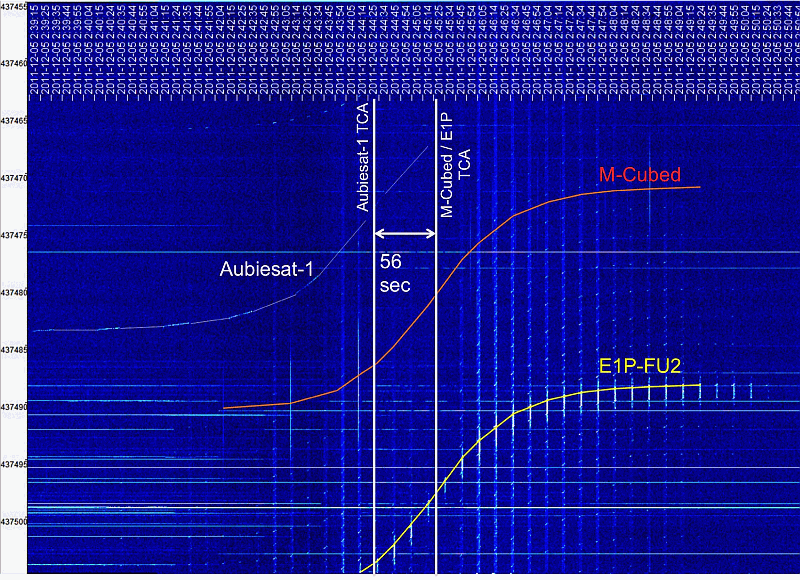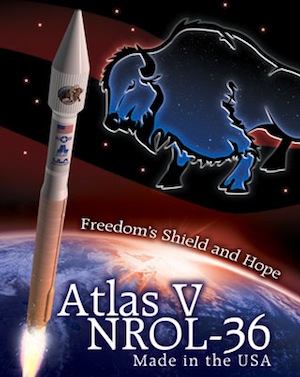 On August 2, 2012 at 07:40 UT an Atlas V rocket is planned to launch a combination of 11 satellites from Vandenberg Air Force Base in California for the US Government and NASA ELaNa university CubeSats.
On August 2, 2012 at 07:40 UT an Atlas V rocket is planned to launch a combination of 11 satellites from Vandenberg Air Force Base in California for the US Government and NASA ELaNa university CubeSats.
The primary mission will launch a pair of US Navy Ocean Surveillance Satellites (NOSS). These satellites carry equipment to track ships and aircraft by triangulation of radio transmissions. The two NOSS satellites have a combined weight of 6500 kg. They will separate a few days after being placed into a 1100 km circular orbit at 63° inclination.
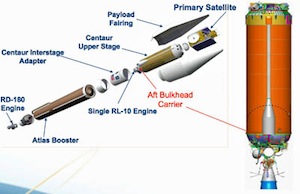 This is the first Atlas V launch with modified helium tanks in the Centaur upper stage. The change has created room in the aft skirt to accommodate 8 P-POD dispensers for CubeSats. This launch carries 11 CubeSats, to be released into 470 x 770 km, 63° orbit about 3 hours after launch and following maneuvers by the Centaur upper stage.
This is the first Atlas V launch with modified helium tanks in the Centaur upper stage. The change has created room in the aft skirt to accommodate 8 P-POD dispensers for CubeSats. This launch carries 11 CubeSats, to be released into 470 x 770 km, 63° orbit about 3 hours after launch and following maneuvers by the Centaur upper stage.
NASA ELaNa Launch and Deployment
3 P-Pods will carry 4 CubeSats as the NASA sponsored “ELaNa VI” cluster:
1. CINEMA (CubeSat for Ion, Neutral, Electron, Magnetic fields)
http://www.eecs.berkeley.edu/Pubs/TechRpts/2010/EECS-2010-83.pdf
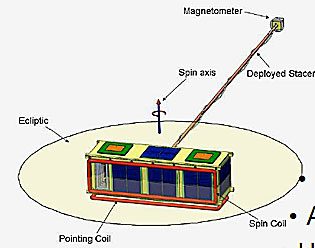 First in a trio of identical nano-satellites studying Space Weather effects in near-Earth space, 3U CubeSat from University of California at Berkeley,
First in a trio of identical nano-satellites studying Space Weather effects in near-Earth space, 3U CubeSat from University of California at Berkeley,
Uplink uses a serial connection with a data rate of 9600 bps.
Downlinks for engineering telemetry and command are in the 2400-2450 MHz range; Science telemetry is in 2200-2300 MHz range.
1 Mbps data rate, Reed-Solomon encoded bit stream.
2. CSSWE (Colorado Student Space Weather Experiment)
http://lasp.colorado.edu/home/about/quick-facts-csswe/
3U CubeSat designed and developed by students at the University of Colorado at Boulder (CU-Boulder). The objective of the science mission is to address fundamental questions pertaining to the relationship between solar flares and energetic particles.
Downlink 437.345 MHz, 9k6 with AX25
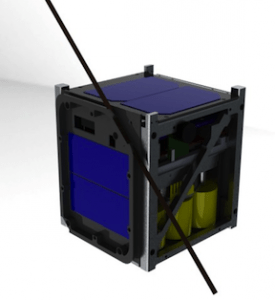 3. CP5 (PolySat)
3. CP5 (PolySat)
http://polysat.calpoly.edu/CP5.php
California Polytechnic State University at San Luis Obispo mission with De-Orbiting Experiment Using A Deployed Thin-Film Mechanism.
Downlink 437.405 MHz at 1 watt, AFSK on LSB AX.25 over NRZI at 1200 bps, every 2 minutes, begins 3.5 hours after first turn-on
4. CXBN (Cosmic X-Ray Background Nanosatellite)
http://universe.sonoma.edu/CXBNanosat/
Morehead State University mission to map the entire sky in the X-ray spectrum using high energy cosmic background radiation measurements in the 30-50 keV range. 2U CubeSat.
Downlink 437.525 MHz, GFSK, AX.25
US Government Payloads
5 P-PODs will carry 7 US Government payloads (list subject to confirmation):
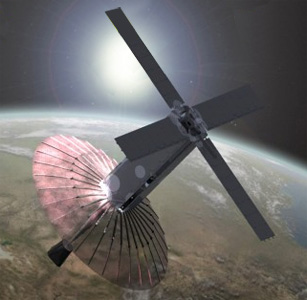 1. Aeneas
1. Aeneas
Aeneas Project
Department of Homeland Security satellite technology demonstration program to track cargo containers worldwide, 3U CubeSat built by the University of Southern California. Proof of concept mission to prove the concept of WiFi based tag tracking from Low Earth Orbit.
First CubeSat to deploy 2.4 GHz Dish Antenna. WiFi transmitter will transmit on 2425.0 MHz with 1 watt of output power.
Downlink 437.600 MHz AX25 1200 bps beacon every 10 second and a spread spectrum two-way link elsewhere in the 70cm band.
2. ORSES (ORS Enabler Satellite)
Operationally Responsive Space office, 3U CubeSat for the US Army Space and Missile Defense Command.
3. Horus
One of a satellite pair (with Re) has optical sensors to detect orbiting payloads and debris for orbit measurement, 3U CubeSat from Lawrence Livermore National Laboratory.
4. Re
Second satellite of a pair (with Horus) has optical sensors to detect orbiting payloads and debris for orbit measurement, 3U CubeSat from Lawrence Livermore National Laboratory,
5. 6. 7. Aerocube 4A, 4B, 4C
Built and operated by the Aerospace Corporation for technical research.

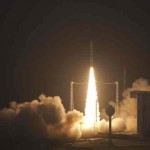 The first Vega, flight VV01, lifted off at 1000 UT from the ESA Spaceport at Kourou in the Caribbean carrying eight student built amateur radio satellites and the LARES Laser Relativity Satellite into orbit.
The first Vega, flight VV01, lifted off at 1000 UT from the ESA Spaceport at Kourou in the Caribbean carrying eight student built amateur radio satellites and the LARES Laser Relativity Satellite into orbit.